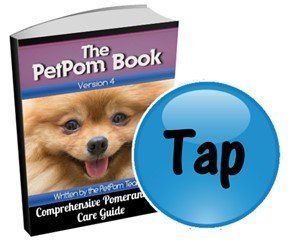Puppy Care
PetPom

The
Pomeranian
Information
Center
Pomeranian Puppy Care
Overview
Bringing home a Pomeranian puppy is a happy and exciting event. But, you may have a lot of questions and be unsure of where to even start.
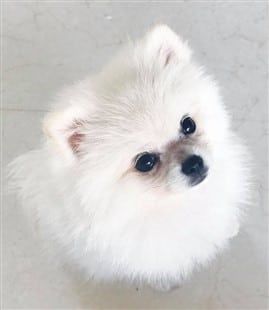
Snow, 4 months old,
photo courtesy of Inna P.
Snow, 4 months old,
photo courtesy of Inna Preza
So, if you are a first time Pomeranian owner, this section will cover what you want to know about, including:
- List of what you'll need to have
- Choosing a veterinarian
- Preparing the house and creating the ideal environment
- Introduction to the house and family
- Feeding tips for puppies
- Tips for puppy care regarding walks and exercise
- Tips for puppy care regarding grooming and first baths
- Top 10 do's and don'ts for puppies
Note: If you are just now getting a Pomeranian, be sure to sign up to become a free PetPom Member.
This will allow you to receive newsletters that announce when new articles are added to the site, know when fun events are starting such as the Annual Pom Halloween Costume Contest, and be able to submit photos of your Pom to be added here.
It's free and only take a moment to join us.
List of What to Have for a New Pomeranian Puppy
- Chosen veterinarian
- Food
- Snacks
- Method to offer filtered water
- Bowls
- Playpen
- Toys
- Bed
- Pee pads
- Leash
- Harness
- Collar (optional)
- Dental care items
- Grooming items - Includes brush, comb, shampoo, conditioner, leave-in spray, and thin yet high-quality absorbent towel
- Optional: Clothing
Ahead, we will discuss these in more detail.
The Importance of Having a Chosen Veterinarian
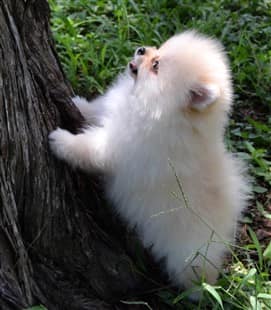
Photo courtesy of Dee Dees Pomeranians in Texas
If you obtained your Pomeranian puppy from a breeder, most will require that you bring your new puppy to the vet within a certain amount of time; this is usually 24 to 72 hours. This is to ensure that your veterinarian concurs that the pup is in good health as per the contract that you were given.
Reputable breeders
will have written health guarantees that if any genetic health issues are found, the pup can be returned and you can receive a replacement puppy.
While it is very common for owners to not want to exchange a puppy, as they have already fallen in love, it is
important to know the health status of your Pom.
Since this window of time is very small, you will want to have the vet already chosen, and if you can, an appointment already set up.
And regardless of a health contract or not, you'll want to know if your Pom is healthy.
In addition, part of caring for your Pom puppy includes timely vaccinations and de-wormings. Puppy vaccinations start at 6 weeks old, and continue until 16 weeks old. After this, there will be booster shots.
The best veterinarian for your new Pomeranian puppy may not be the closest one to you. You may wish to visit a few in your area before you decide. It can be beneficial to opt for one that has experience with toy breeds; however, office hours and how after-hour issues are handled are things to consider as well.
In addition, part of caring for your Pom puppy includes timely vaccinations and de-wormings. Puppy vaccinations start at 6 weeks old, and continue until 16 weeks old. After this, there will be booster shots.
The best veterinarian for your new Pomeranian puppy may not be the closest one to you. You may wish to visit a few in your area before you decide. It can be beneficial to opt for one that has experience with toy breeds; however, office hours and how after-hour issues are handled are things to consider as well.
Getting the House and Yard Ready for a New Pom Puppy
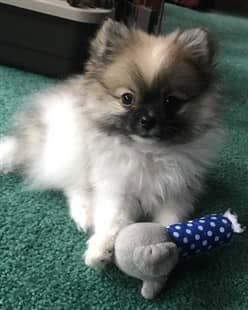
Mia Bella, at 3 months old,
photo courtesy of Patricia Roth
Here is what should be done to ready your puppy's environment:
1. Puppy proof the house.
Your Pom will be tiny, but never underestimate his ability to find and reach things. And nothing is off limits to a pup in regard to mouthing them; this is done out of curiosity.
Every household item that you can think of (shoes, books, remotes, etc.) should be placed up high. Electrical cords must not be accessible. Secure them out of reach or use cord concealer like PetCords Cord Protector .
.
Scan the floors for small objects; and this should be done on a regular basis, not just to prepare for your new puppy.
2. Proof the yard.
Scan the yard for any small or sharp objects. Remove any bags of lawn care chemicals. Fill in any holes. Address any insect issues such as bee hives.
3. Decide on your Pom's areas.
You'll want to choose a spot that will serve as your Pom's personal area.
This will be where your Pom spends his time when home alone and when you are home but cannot closely supervise. This area will be where a canine playpen
is placed (more ahead), which will hold his most helpful toys, a bed, and other items.
This will be where your Pom spends his time when home alone and when you are home but cannot closely supervise. This area will be where a canine playpen
is placed (more ahead), which will hold his most helpful toys, a bed, and other items.
You will want this to be centrally located, and not an isolated area. But, it should be away from foot traffic and any possible drafts. Often, a corner in the living room or the kitchen are good spots.
You will want this to be centrally located, and not an isolated area. But, it should be away from foot traffic and any possible drafts. Often, a corner in the living room or the kitchen are good spots.
The First Days of Introducing a Pomeranian Puppy to a New House
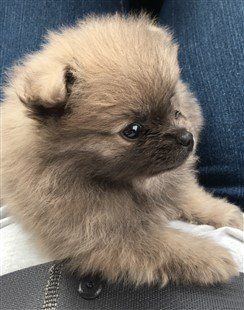
Bud,photo courtesy of Donna & Harry Leverett
Bud, at 7 weeks old,
photo courtesy of Donna & Harry Leverett
Here are 3 tips to keep in mind:
1. Just getting your Pomeranian puppy home is an event.
While it will be extremely tempting to cuddle him on your lap while being driven home, this is incredibly dangerous. You will want to have an appropriately sized raised booster car seat for you pup.
And, later as your puppy matures, there can be lots of motion sickness without a car seat to keep him up high where he can see out of the windows.
A good one to consider is the Snoozer Lookout Pet Car Seat in Size Small .
.
2. Keep things calm.
There's no doubt lots of excitement felt as you walk through the door with your Pomeranian for the first time. But, all sorts of commotion can be very overwhelming for a puppy that just left his mother and littermates.
Limit hellos to immediate family only. Have each person greet the pup one at a time. Do not pass the puppy around up high; have this be with people kneeling down.
3. Acclimation.
It takes a while for a new puppy to get used to his new home. Allow your puppy to sniff around. For the first few weeks, bring your pup to his resting and sleeping area (more ahead), and to his food and water bowls throughout the day to remind him where he can rest, eat, and drink.
Do not expect immediate bonding. Young puppies may seem aloof. As you move ahead with house training, walks, grooming, and so forth, bonds will be made and strengthened.
Puppy Care in Regard to Food and Water
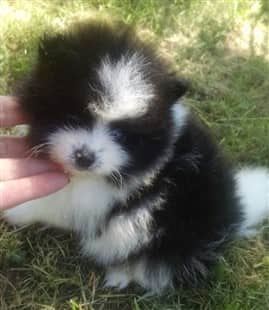
Finnley, at 5 weeks old, photo courtesy of Stacy
Finnley, at 5 weeks old,
photo courtesy of Stacy V.
Frequency: If puppies do not eat often enough, there is a risk of hypoglycemia, which is a rapid drop in blood sugar levels. Signs include weakness, sleepiness, and confusion. Minor cases can be treated by rubbing a dab of honey onto the gums; moderate to severe cases can be life threatening and require immediate vet care.
In addition, empty stomachs can lead to stomach bile being thrown up.
New Pomeranian puppies that are 8 or 9 weeks old should be free-fed for the first month. This means that fresh food should be left out at all times.
Puppies 12 weeks and older should have 3 meals per day, plus a minimum of 4 snacks. This schedule often continues into adulthood.
Amount:
While your Pomeranian puppy needs to eat often, it will be a very small amount of food. A puppy weighing just a few pounds will only be eating 1/4 to 1/2 cup per day. That means that that amount needs to be split into 3 meals.
Once you have an excellent food picked out (more ahead), check the labeling on the package; this is the very best guideline, and it will be based on weight.
Once you have an excellent food picked out (more ahead), check the labeling on the package; this is the very best guideline, and it will be based on weight.
Best foods:
There are many owners that are having a hard time with their adult Poms, wishing that they could start over and do things better from the beginning. So, be sure to take the time to choose the absolute best foods right now, while your Pomeranian is still young.
Food allergies are a top concern; this can cause terrible skin issues including rash and itchiness, and stomach distress. You'll want to avoid common triggers such as chemical preservatives, artificial coloring, corn, soy, wheat and grains (with rice often being the exception), and by-products.
You'll also want the kibble to be designed for small dogs, so that it is properly sized and has the right levels of protein and other important nutrients. An excellent choice is Wellness Complete Health Small Breed Puppy Food ; this is a turkey, salmon, and oatmeal recipe that has lots of added bonuses including DHA for brain development.
; this is a turkey, salmon, and oatmeal recipe that has lots of added bonuses including DHA for brain development.
(continued below)
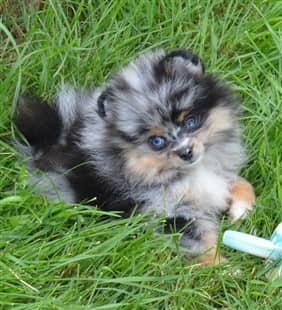
Pumba,
blue-eyed, tri merle,
photo courtesy of Laura Montanez
Snacks
- Snacks will tide your puppy over in between meals, helping to prevent those crashes of blood sugar that we mentioned earlier. And treats are vital; giving reward will help teach your puppy about housebreaking, and good behavior such as not barking or jumping.
And it's vital to choose superior treats and snacks, which means avoiding allergy triggers, and offering properly sized bites.
An excellent choice is Wellness Puppy Bites Natural Grain-Free Treats . There are 2 types; The crunchy chicken & carrots is perfect for in between meals. The soft lamb & salmon is ideal to give as reward when training.
. There are 2 types; The crunchy chicken & carrots is perfect for in between meals. The soft lamb & salmon is ideal to give as reward when training.
Water
- Fresh, cool water should be available at all times. Give careful thought to the dangers of unfiltered tap water. It is not an exaggeration to say that the tap water in the US is filled with toxins and contaminants.
As CNN reports on Chromium-6, this carcinogenic chemical that was brought to the nation's attention via the Erin Brockovich movie has been found in the tap water of 218 million Americans.
If that is not bad enough, tap water legally contains a range of toxins including arsenic, lead, pollutants from factory run-off, and chlorine (which kills bacteria, but is a toxin in itself). There may also be fluoride, which started off as a rat poison and is now used to protect human teeth, but is toxic to dogs.
If that is not bad enough, tap water legally contains a range of toxins including arsenic, lead, pollutants from factory run-off, and chlorine (which kills bacteria, but is a toxin in itself). There may also be fluoride, which started off as a rat poison and is now used to protect human teeth, but is toxic to dogs.
You can protect your Pomeranian puppy by having a filter connected to your kitchen tap, offering bottled spring water, or by using a filtered water pitcher.
For a filtering pitcher, the Aquagear Water Filter Pitcher
 is quite amazing; this filters out 2000% more contaminants than a Brita, including Chromium-6, mercury, fluoride, and chlorine. It is made from 100% FDA approved food grade material, and is 100% vegan. To top it off, it is guaranteed for life.
is quite amazing; this filters out 2000% more contaminants than a Brita, including Chromium-6, mercury, fluoride, and chlorine. It is made from 100% FDA approved food grade material, and is 100% vegan. To top it off, it is guaranteed for life.
Bowls
- As with many things that owners wish they could have a do-over for, the type of bowls used are at the top of this list. If you see a Pomeranian with a faded, pink nose, there's a good chance that he's either eating an inferior food, has sun damage, or has been eating or drinking from a plastic bowl.
Alternatives are ceramic or stainless-steel; since ceramic can fracture, we recommend stainless-steel. The best type of bowls
will also be sized properly so that a puppy can easily reach his food and drink up his water.
You may find that a set that sits securely in a base like SuperDesign's Stainless Steel Water & Food Bowl Set
 helps prevent slipping and keeps things tidy. As an added plus, there are 5 different base colors to choose from.
helps prevent slipping and keeps things tidy. As an added plus, there are 5 different base colors to choose from.
The Importance of a Defined Area
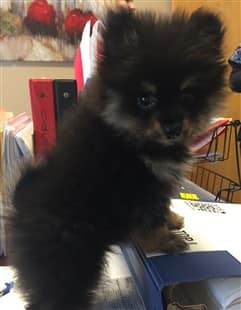
Rose, at 12 weeks old,
photo courtesy of Donna & Harry Leverett
It's important that your Pomeranian puppy has a defined area. If you allow a pup to have free reign in the house, this is asking for all sorts of trouble.
Keeping your Pom in one spot is vital for:
- Housebreaking a puppy; this prevents pee and poo from being deposited all over the house.
- Keeping a Pom safe and comfortable when you are not home or cannot supervise your puppy; the area will keep your Pom in one place, with all of his necessities such as toys, food, water, bed, and so forth, right there.
- Allow for a safe and comfortable area to sleep. If you let your puppy sleep in your bed, you will have pee and poo in your bed. In addition, it is very easy to accidentally injure a tiny puppy if in the bed together.
- Offering an area to retreat to; young puppies are often very hyper, but then wear out quickly. And, they can get overwhelmed very easily. For times that your puppy wants to get away from things for a bit, a defined area allows for this.
One of the best methods to provide this is via an indoor canine playpen.
It's important that your Pomeranian puppy has a defined area. If you allow a pup to have free reign in the house, this is asking for all sorts of trouble.
Keeping your Pom in one spot is vital for:
- Housebreaking a puppy; this prevents pee and poo from being deposited all over the house.
- Keeping a Pom safe and comfortable when you are not home or cannot supervise your puppy; the area will keep your Pom in one place, with all of his necessities such as toys, food, water, bed, and so forth, right there.
- Allow for a safe and comfortable area to sleep. If you let your puppy sleep in your bed, you will have pee and poo in your bed. In addition, it is very easy to accidentally injure a tiny puppy if in the bed together.
- Offering an area to retreat to; young puppies are often very hyper, but then wear out quickly. And, they can get overwhelmed very easily. For times that your puppy wants to get away from things for a bit, a defined area allows for this.
One of the best methods to provide this is via an indoor canine playpen.
A playpen like the Iris 24'' 4-Panel Playpen with a Door
 is easy to set up, is portable, offers a claustrophobic-free area to relax, and is just the right size to hold all of a puppy's belongings. This is highly preferred to a crate or cage, which often causes both physical and emotional stress.
is easy to set up, is portable, offers a claustrophobic-free area to relax, and is just the right size to hold all of a puppy's belongings. This is highly preferred to a crate or cage, which often causes both physical and emotional stress.
Recommended playpens are below.
On mobile, you may need to turn your screen horizontal to see all four.
Note that you may want to choose one that has a door; this can be left open when you are home and can supervise, so that a puppy can enter and exit at will.
And next, we will cover what you'll want to have within this.
What to Have in the Pen for Your Puppy
While some of these items will be used outside of your puppy's pen, these should all be included in the set-up you create for your Pom during times of being home alone, at night, and when you cannot supervise your pup.
Pee pads
- Though the goal for most owners is to train their puppy to go to the bathroom outside, and that is our preferred method as well, there needs to be a system in place to control messes until a pup is fully trained.
While keeping your Pom in his pen will keep accidents to one area, placing down pee pads will facilitate easy clean-up. This will also help protect your floors.
Toys
- Toys will be needed to soothe teething discomfort, provide security when alone, and to encourage independent play. A treat-release toy can also be a great method to offer food while you are away.
Toys
- Toys will be needed to soothe teething discomfort, provide security when alone, and to encourage independent play. A treat-release toy can also be a great method to offer food while you are away.
It is suggested to have two buckets of toys; one that is kept out and one that is tucked away. You can swap out toys every couple of weeks so that your puppy always has something 'new'. Be sure to routinely clean all toys with hot water and dish soap to stop bacteria build up.
While there are 5 different types of toys
that your Pom will need, depending on age and whether or not there are issues with separation anxiety, what you'll want to have right away for a new puppy are chew and teething toys.
One good choice is the Nylabone Just For Puppies Petite Chew Toy ; which has tiny little nubs that help with teething and is made of a very soft, easy-to-chew material.
; which has tiny little nubs that help with teething and is made of a very soft, easy-to-chew material.
And another is the Nylabone Just for Puppies Extra Small Pacifier Chew Toy , which has bacon flavor to entice a puppy to mouth it, and has nubs to make gums feel good.
, which has bacon flavor to entice a puppy to mouth it, and has nubs to make gums feel good.
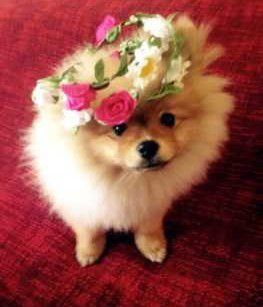
(continued below)
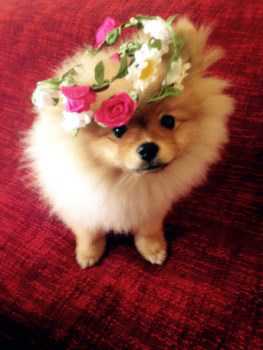
Cocoa Macaroon, Photo courtesy of Shruthi & Raghuveer
Cocoa Macaroon, 6 months old
Photo courtesy of owners: Shruthi & Raghuveer
A bed
- You may be wondering if your Pomeranian puppy really needs to have his own bed. Can't he just cuddle up with you? While there will be plenty of times to snuggle with your pup, there are also good reasons to have a bed for your Pom:
- When you are away. Chances are that there will be times when you need to leave your Pom at home. And for these times, you'll want your pup (and then your older dog) to be able to be comfortable.
- For at night. As we touched on earlier, it is unsafe for a puppy to sleep in his owner's bed, as well as this being a surefire way to have urine and feces deposited on your mattress.
- For proper support. Unfortunately, the Pomeranian is one of the toy breeds that is prone to both hip dysplasia and patella luxation. And while having the right support cannot avert these issues, it can help to prevent aggravation of the joints.
So, you'll want to choose a properly sized quality bed
for your puppy. Most pups do best with bolstered beds, which offer a sense of security.
There are a few key elements to keep in mind. Memory foam will offer proper support. Also, you'll want the step into the bed to be relative low for easy access.
In addition, you'll find it very helpful if the cover is both water-resistant and washable. One that meets all of these requirements and is not that bad on the budget is the Orthopedic Pet Sofa Bed in Size Small - By Petlo .
.
Pom Puppy Care Regarding Walks and Exercise
Here are 3 things to know:
1. You can start taking your Pomeranian puppy outside for walks
and to other places after puppy shots are complete. We personally suggest waiting 2 weeks passed this point, to be safe.
Before this time, a puppy will not be completely protected from disease that can be picked up in any area that dogs or wildlife could have previously been.
While your Pom will be receiving vaccinations and boosters throughout his life, this refers to the distemper, measles, and parainfluenza shots given at 6 and 8 weeks, and the DHPP combo which is for distemper, adenovirus, parainfluenza, and parvovirus, which is usually given by the 10 to 12 week mark.
2. Exercise will be an important part of your Pom's life; in fact, regular exercise
will help extend your dog's life span, and will play a factor in your dog's happiness level.
(continued below)
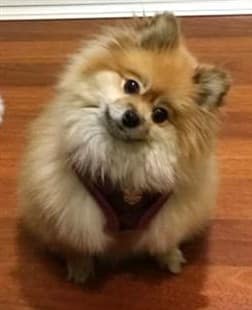
Lulu, photo courtesy of Lynn
As soon as your Pom puppy is protected via his inoculations, you can start two daily walks, each lasting 20 minutes, and at a pace that is brisk for your pup.
3. Part of caring for a Pomeranian puppy means protecting your little guy or gal from injury.
So, this means that walking your Pom on a harness, and not a collar, is vital.
Pomeranians, being toy breed dogs, are prone to collapsed trachea. This is a terribly painful condition. With this, weakened tracheal rings are prone to collapsing inward. A trigger for this is pressure due to being on leash and collar; all stress is placed on the neck.
To avoid this, slip a harness on your puppy. Not only does this keep the neck free of pressure, since it is distributed over the much stronger and muscled back, chest, and shoulders, but it's also much more helpful in controlling a puppy to walk where you wish.
A great choice for a comfortable harness is the Puppia Soft Dog Harness in Size Extra Small .
.
This is adjustable, and comes in 12 different colors.
This is adjustable, and comes in 12 different colors.
Pom Puppy Care in Regard to Grooming
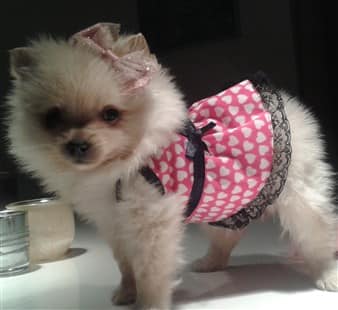
Tiny female Pom puppy, photo courtesy of Veronika J Uricko (a Pomeranian breeder in Slovakia)
You can start giving your Pomeranian puppy baths right away. Just be sure to do this in a clean kitchen sink, using warm water. Often, running water startles young pups, so filling the sink with a couple of inches beforehand is best.
Baths should be given every 3 weeks, even if the pup does not look dirty. This is because body oils will be accumulating regardless, and if these are not washed off, it can block skin pores and start to get rather stinky.
You'll want to use a superior, quality shampoo that is good for the coat and skin, since this breed can be quite sensitive to products.
The line of Earthbath All Natural Shampoo and Conditioner
 is excellent; these can prevent issues including dry skin, treat issues including itching, and will leave the coat looking soft and fluffed.
is excellent; these can prevent issues including dry skin, treat issues including itching, and will leave the coat looking soft and fluffed.
Be sure to pat, not rub, when drying.
In between baths, regularly wipe your puppy down with grooming wipes. We recommend Earthbath All Natural Grooming Wipes
 .
.
In between baths, regularly wipe your puppy down with grooming wipes. We recommend Earthbath All Natural Grooming Wipes .
.
Top 10 Pomeranian Puppy Care Do's and Don'ts
While listing out complete care of a Pomeranian puppy would fill up a book, and in fact is why we offer The PetPom Book, which guides you through every step of owning a Pom, here are our top 10 do and don't tips:
1. Don't assume your puppy knows better.
It'll be up to you to teach right from wrong.
2. Do be patient and kind.
Good behavior should be rewarded with praise and a treat. Behavior that is not appreciated should never be handled by yelling or getting upset.
For some behaviors, ignoring a Pom is best (when done completely and utterly, a pup will start to question his behavior and the reason why he may be being 'banished' from the pack.)
Other times, such as for barking or destructive chewing, interruption and distraction or refocusing will work.
(continued below)
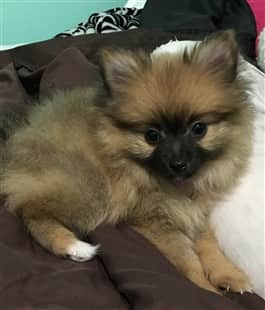
Catalina, 2.5 months, photo courtesy of Karla
Catalina, at 2 and 1/2 months old,
photo courtesy of Karla
3. Do try to spend a lot of time with your Pom.
Your Pomeranian will only be a puppy for 1 year, and this time goes by quickly.
This is also a vital time for learning how to interact and behave.
Every day is an opportunity to learn something. Talk to your Pom, explore places together, work on commands, play games.
3. Do try to spend a lot of time with your Pom.
Your Pomeranian will only be a puppy for 1 year, and this time goes by quickly. This is also a vital time for learning how to interact and behave. Every day is an opportunity to learn something. Talk to your Pom, explore places together, work on commands, play games.
4. But don't feel bad when you can't be there every second. Part of caring for a Pom puppy is teaching independence. If your Pomeranian has a hard time being home alone, take
steps to help with separation anxiety.
5. Do take the time to carefully choose foods
for both main meals
and snacks. Preventing the ill effects of inferior foods is a lot easier than helping a Pom recover from them.
6. Don't allow your puppy to trick you with stubborn eating habits.
If your puppy refuses to eat his food, but you know it's a very good brand, remain firm. Chances are that he's waiting for you to cave in. This can become quite a game if owners allow it.
7. Do change your care tactics according to the seasons.
Pomeranians have different needs depending on the weather. In the summer, your puppy may need a cooling mat to stay comfortable like the The Green Pet Shop's Self Cooling Pet Pad .
.
But in the winter when the temperate dips and there may be drafts, your puppy may need a soft sweatshirt like the Zack & Zoey Hoodie
 to prevent chills and shivering.
to prevent chills and shivering.
And on freezing days, weather-proof clothing like coats and jackets
may be needed for a puppy to tolerate being brought outside.
8. Don't expect your Pom to look like anyone else's Pom.
This is an amazing breed that comes in colors ranging from white to black and everything in between. There are also countless patterns and markings.
Some Poms are tiny, some are large (even 20+ pound throwbacks). Some have the classic fox-face, others are more compact with the unofficial teddy bear or baby doll face.
Your Pom will never look just like any other that you see and will be a one-of-a-kind cutie-pie.
9. But do expect your puppy to change as he matures.
Puppies are round, adults are sleeker. Puppies have soft fine coats, adults have thick coats with guard hairs. Color may dramatically change as well. What was a tiny marking may cover half the body once a pup is done growing. And sabling that was strong when a Pom was young may be essentially gone once he matures.
10. Do give your Pom unlimited love.
This one is a given, it's impossible not to!
You May Also Like:
Top 10 Pomeranian Care Tips
(that owners are not doing). Review if you're doing all of the needed steps to care for a Pom of any age.
Pomeranian Puppy Teething
- Age this happen, exactly how to deal with chewing needs.
How to Get Rid of Tear Stains on a Pomeranian
- If your pup has started developing red or brown hairs around the eyes, it's time to take steps to get rid of this discoloration.
Age You Can Bring a Pomeranian Puppy Outside
- When you can safely bring your Pom out and elements to be aware of.
Things Pomeranians Love
- Sure to keep your Pom happy.
If you email photos to us, you agree that PetPom is given free copyright to use at our discretion. We will always credit the photo to the name of the Pom's owner(s) if it is supplied.
Email: Contact@PetPom.com
All text, images and artwork protected by US and International copyright laws. All rights reserved. Copyright PetPom.com
We are a participant in the Amazon Services LLC Associates Program, an affiliate advertising program designed to provide a means for us to earn fees by linking to Amazon.com and affiliated sites.

